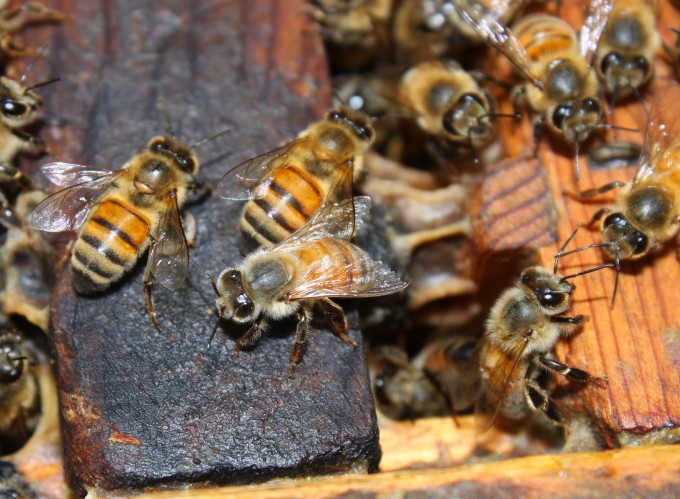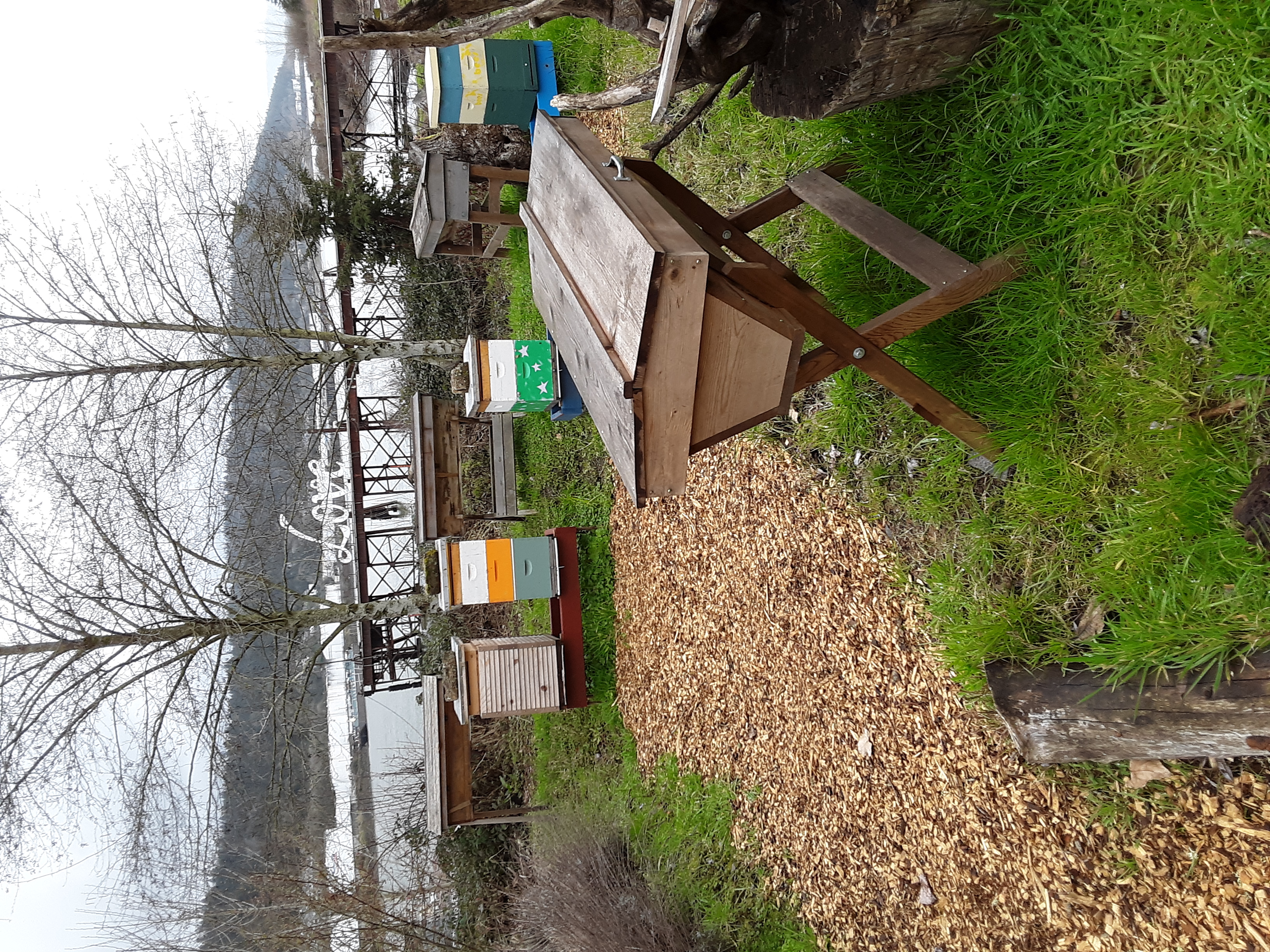Signs of a tracheal mite infestation (acariosis) are not unique and mimic other diseases: increased winter loss and slow build up in the spring, a reduction in honey production, abnormal clustering in the winter, K-wingK-wing:
describes adult bee wings that remain partially open rather than tightly folded on top of the abdomen, and with hind wing over front wing, resembling the letter K; caused by tracheal mite infestation. , fecal spots on the hive entrance, crawling bees found in front of the hive that are unable to fly, and premature death.
, fecal spots on the hive entrance, crawling bees found in front of the hive that are unable to fly, and premature death.
The honey bee tracheal mite Acarapis woodi, first discovered in the U.S. in 1984, is a small, oval, eight-legged, whitish mite barely visible without magnification, Adult mites reproduce within the respiratory (tracheal) system of host adult honey bees. Large tracheal branches of the thoraxthorax:
the middle region of the adult bee body, which lies in between the head and the abdomen; consists of three segments: pro-, meso-, and meta-thorax; thorax attachments include three pairs of legs and two pairs of wings
are the most heavily infested (and easiest to sample). The mites puncture the tracheal walls to feed on host hemolymphhemolymph:
the insect equivalent of mammalian blood
, leading to host stress, secondary infections, and premature adult or sometimes entire colony death.
Levels typically elevate during winter confinement, when bees are shipped in packages or are otherwise confined. High infestation levels correlate with colony stress, reduced worker efficiency, reduced colony honey storage, and lower winter colony survival.
Detection of tracheal mite infestation is not easy. Signs of infestation include K-wingK-wing:
describes adult bee wings that remain partially open rather than tightly folded on top of the abdomen, and with hind wing over front wing, resembling the letter K; caused by tracheal mite infestation. condition of adults, crawling bees outside the hive, and dwindling colony populations that are weak in the spring. Such general signs of infestation mimic other stress diseases and viruses in honey bees.
condition of adults, crawling bees outside the hive, and dwindling colony populations that are weak in the spring. Such general signs of infestation mimic other stress diseases and viruses in honey bees.
To confirm an active tracheal mite infestation, remove the head and first pair of legs from the underside of a chilled bee, and cut a thin disc from exposed tissue. Place on a microscope slide or a petri dish and clear muscle with 10% lactic acid solution. Examine under 40X magnification. In heavily infested tracheae, it may be possible to see darkening of tracheal wall and actual presence of adult or nymphal mites or eggs within the trachea (see photo at right).
Tracheal mites are also called acarine mites. The condition is termed acariosis and also Isle of Wight Disease (IoWD). Although originally IoWD was identified as due to tracheal mites, it might also have been related to both chronic bee paralysis virus (CBPV) and tracheal mite. IoWD, first detected on Isle of Wight, caused widespread losses of bees in southern England and Ireland in the early 1900s. It was first noted in the U.S. in 1984.
Grease patties were once widely used for tracheal mite control. A tracheal mite grease patty is a mixture of vegetative grease (Crisco®) mixed in a 1:3 ratio (by volume) with granulated sugar. The ingredients are mixed to make a patty with the consistency of peanut butter and sandwiched with waxed paper. The patty should be placed on the bottom board of a hive (sometimes recommended for top bars but not in hot weather conditions). The grease is thought to impair the ability of tracheal mite adults to recognize new hosts.
USDA Agricultural Research Service. 2016 update. Tracheal Mite. U.S. Department of Agriculture Agricultural Research Service. Accessed 2023. https://www.ars.usda.gov/northeast-area/beltsville-md-barc/beltsville-agricultural-research-center/bee-research-laboratory/docs/tracheal-mite/
Blackiston H. 2021. How to Control a Tracheal Mite Problem in Your Beehive. For Dummies. Accessed 2023. https://www.dummies.com/home-garden/hobby-farming/beekeeping/how-to-control-a-tracheal-mite-problem-in-your-beehive/
Hood MW. n.d. Honey Bee Tracheal Mite. Clemson Cooperative Extension. Accessed 2023. https://www.clemson.edu/extension/beekeepers/fact-sheets-publications/tracheal-mite-honey-bee.html
Texas Apiaryapiary:
a place where beehives and beekeeping equipment are located; also called a bee yard. An out-apiary is a site away from the owner’s residence. Inspection Service. n.d. Tracheal Mites. Texas A&M AgriLife Research. Accessed 2023. https://txbeeinspection.tamu.edu/tracheal-mites/
Inspection Service. n.d. Tracheal Mites. Texas A&M AgriLife Research. Accessed 2023. https://txbeeinspection.tamu.edu/tracheal-mites/
Denmark HA, Cromroy HL, and Sanford MT. 2000. Honey Bee Tracheal Mite. Featured Creatures. Accessed 2023. https://entnemdept.ufl.edu/creatures/misc/bees/tracheal_mite.htm
Moore PA, Wilson ME, Skinner JA. 2019. Honey Bee Tracheal Mites: Gone? But not for Good. Bee Health. Accessed 2023. https://bee-health.extension.org/honey-bee-tracheal-mites-gone-but-not-for-good/
Cambray GA. 2021 update. What Are K Wing Bees? Beekeeper Tips. Accessed 2023. https://beekeepertips.com/k-wing-bees/